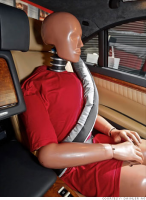
— Seat belts save lives. That slogan is often used, and for good reason. It's true.
The seat belt is probably the greatest in-vehicle safety invention since the dawn of automobiles. But there has always been a problem.
According to the National Highway Traffic Safety Administration, rear-seat passengers are much less likely to wear a seat belt compared to passengers in the front seat.
Ford Motor Company wanted to change this statistic by not only creating a seat belt that offered more safety, but one that was also more comfortable to wear. More comfort means a greater chance a passenger will buckle up.
Ford engineers worked 10 years on a more flexible seat belt, one that allegedly offered more safety by embedding an air bag into the seat belt. After all their hard work, the first inflatable rear seat belt was introduced in the 2011 Ford Explorer.
At the time, Ford said the inflatable safety belt would spread impact forces across more than five times the body area compared to conventional seat belts. According to testing performed by Ford, this reduced pressure on the chest while helping control head and neck motion.
Additionally, Ford said the seat belts were softer and more flexible, so rear-seat passengers would be more comfortable.
Now comes word that Mercedes-Benz will start offering some of their luxury models with an inflatable rear seat belt called the Beltbag. Similar to Ford's inflatable safety belt, the Beltbag will inflate in a fraction of a second when its sensors detect a crash.
The potential for additional safety while motoring down the highway is an appealing thought to any driver or passenger.
Automakers increasingly are installing devices and technology that promise to make our trip safer and more enjoyable. The problem is the lack of real-world testing to know what increases safety and what doesn't.
A good example is lane departure systems that held enormous promise as a way to decrease injuries and insurance claims.
Real-world research thus far shows the technology is associated with increased claim rates under collision and property damage liability coverages and for injuries to occupants. The exact opposite of what was intended.
In the world of inflatable seat belts, Ford and Mercedes say their internal testing proves the effectiveness of the technology. It's quite possible this will turn out to be the case.
One study performed at the University of Virginia Center for Applied Biomechanics found the inflatable belt helped in most crash situations, although in one scenario the air bag "resulted in a statistically significant, but small magnitude increase in maximum forward head excursion."
Researchers said the results suggest an inflatable rear seat belt system may provide some benefit for adult rear seat occupants in frontal collisions, even in relatively low-speed impacts. But they admit much more testing is needed.




